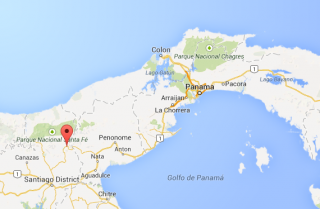El Retiro, Panama
![]()
![]()
![]()
![]()
![]()
![]()
![]() Click on Programs to learn more about their work in this community.
Click on Programs to learn more about their work in this community.
General Information

| Population* | 1,500 |
| Number of homes | 300 |
| Avg # of people per home | 5 |
| Number and % of children | 150 under the age of 12, 100 under the age of 5 (10% and 6.6% respectively) |
| Electricity | In some houses |
| Corregimiento | El Retiro |
| District | Cocle |
| Corresponding Health Center | Rio Hato |
| Distance from compounds | 1.5 hours |
| Road conditions | Good |
* Population does not reflect how many patients will be seen on medical
brigades as many people from surrounding communities come seeking
Medical Brigades medical attention.
Top Needs Expressed
The top needs expressed by key community members are improvements in education, health, reforestation and protection of the environment, and living conditions.
El Retiro’s education system currently offers a primary school (Kindergarten -- 6th). There are about 90 students who attend the school which is run by four teachers as well as the school director Leyda Bakkasco.
El Retiro has a water system which is a gravity-based aqueduct that approximately 285 of the 300 houses have access to. It costs one dollar a month to have access to the water and it is available 24 days out of the month.
There is a water committee within the community made up of 7 community members and is lead by the president Viviano Rodriguez. Currently, the water is treated with chlorine for purification, and no one in the community has water filters in their homes.
El Retiro has a Puesto de Salud (Health Facility). There is no access to dental attention at this facility within the community. The most common diseases are the common cold, diarrhea, and severe vomiting. 50% of the community has a toilet connected to the aqueduct that functions, 75% have functioning latrines, and 90% of the community members have both a gas stove and cement floors throughout the house.
Most of the homes in the community are made up of blocks and zinc. The main source of income for the community members comes from agriculture. The main products from agriculture include corn, yucca (similar to potato), yams, plantains, tomatoes, and animal products. The other sources of income for the community (about 5% of the community income) come from technical positions or tourism.
The community contains some small businesses including a cantina (canteen), kiosk, general store, and a super market.
There is no environmental committee in El Retiro. There are both individual plots as well as collective space that could be used for environmental projects. 1 -- 25% of families cultivate vegetables on their own plots, as opposed to communal plots. Trash is disposed of either by burying it in the ground or burning it.
Community members are able to seek legal processes at the local town hall, however, accessing this is not convenient for the communities. The most common needs involving legal services are marriage, domestic violence, and land ownership.
El Retiro has received a medical/dental "brigade" from Minsa in 2015 for a medical/dental clinic. However, no other organizations have yet visited the El Retiro community.
The top needs expressed by key community members are improvements in education, health, reforestation and protection of the environment, and living conditions.